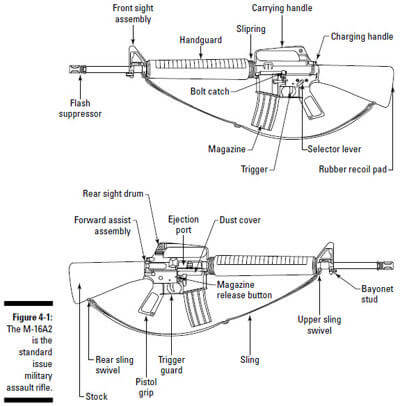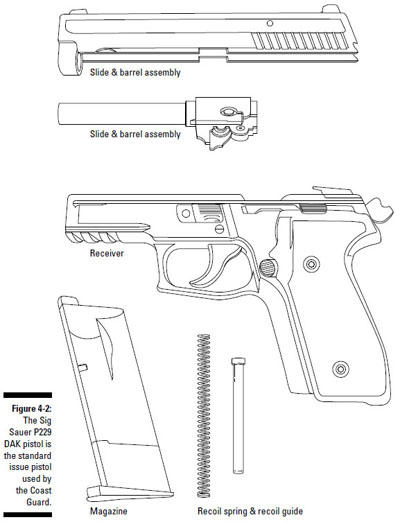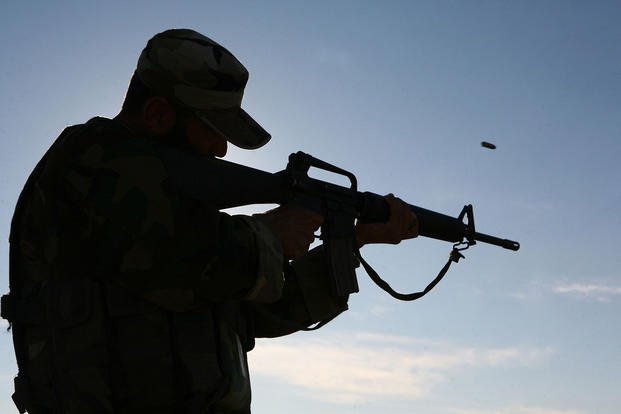Discovering the Weapons Used in Basic
Many types of weapons are used in the U.S. military. However, in military basic training, you’re required to be familiar with only a few weapons. If your military job requires you to know about additional weapons and how to use them, you’ll receive additional training during your military job school.
M-16A2 Assault Rifle
The M-16A2 rifle (see Figure 4-1) is the standard military rifle used for combat. It's carried by pretty much every military member in a combat zone. Most people simply call it the M-16.
Tip: Some of the military branches have converted to the M-16A4 rifle, which is the upgrade to the M-16A2, so don’t be surprised if you receive that rifle instead.
The M-16 has been around in one version or another since the Vietnam War. (The first version, the M16A1, entered Army service in 1964.) Its longevity is a credit to its usefulness as a general assault weapon. The M-16 is quite simply one of the finest military rifles ever made (although advocates of the M-4 Carbine, described in the next section, may argue with me).
The rifle is simple to operate and puts out a lot of lead. The M16A2 5.56mm rifle is a lightweight, air-cooled, gas-operated, magazine-fed, shoulder- or hip-fired weapon designed for either automatic fire (3-round bursts) or semiautomatic fire (single shot) through the use of a selector lever. The weapon has a fully adjustable rear sight.
The bottom of the trigger guard opens to provide access to the trigger while wearing winter mittens or chemical protective gear. The upper receiver/barrel assembly has a fully adjustable rear sight and a compensator that helps keep the muzzle down during firing. The steel bolt group and barrel extension are designed with locking lugs that lock the bolt group to the barrel extension, allowing the rifle to have a lightweight aluminum receiver.
In basic training, recruits of the Army, Air Force and Marine Corps will fire this weapon. Navy recruits will fire a computerized simulator of the M-16 rifle. This simulator is almost like firing the real thing. (The computerized rifle even kicks and makes a loud noise.)
The Coast Guard is the only branch that does not fire the M-16 rifle during basic training. However, Coast Guard recruits receive classroom training, explaining how to fire the weapon and practical training for disassembly, cleaning and reassembly. If you later receive a Coast Guard job that requires you to carry an M-16, you’ll go through additional training, including actually firing the weapon.
 |
M-4 Carbine
The M-4 combat assault rifle first entered Army service in 1997. The rifle is the standard weapon used by some Army units, such as the 82nd Airborne Division, and special operations units, such as Army Rangers.
With a shortened barrel and collapsible stock, the M-4 is ideal for close quarter marksmanship where little weight and quick action are required. Firing a standard 5.56 millimeter round (the same as the M-16), the weapon weighs a mere 5.6 pounds (empty). A revised rear sight allows for better control of the weapon out to the maximum range of the ammunition used. With the PAQ-4 (Infrared Sight) mounted on the forward rail system, the M-4 can be fitted for increased firepower.
The M-4 Carbine can also be fitted with the M-203 40mm grenade launcher. The M-203 is a lightweight, compact, breech loading, pump action, single shot launcher. The launcher consists of a hand guard and sight assembly with an adjustable metallic folding, short-range blade sight assembly and an aluminum receiver assembly, which houses the barrel latch, barrel stop and firing mechanism. The launcher is capable of firing a variety of low velocity 40mm ammunition. The launcher also has a quadrant sight that may be attached to the M-4 carrying handle and is used when precision is required out to the maximum effective range of the weapon.
Some Army recruits (usually those in infantry training) will get a chance to carry and qualify with the M-4 instead of the M-16. Many infantry Marines will be trained on the M-4 during Marine Corps infantry training, which follows basic training.
M-9 Pistol
Did you know that in combat, mostly officers carry handguns? Most enlisted don't. Notable exceptions are military police and special operations forces.
The M-9 pistol is the primary sidearm for all military services, except the Coast Guard. It entered the services in 1985 (1990 for the Army). The adoption of the M-9 pistol was the result of a congressional mandate to equip all U.S. services with a standard handgun.
The M-9 meets the strict requirements for functional reliability, speed of first shot, rapidity of fire, speed of reloading, range, penetration, and accuracy to 50 yards. Also, the pistol's components are interchangeable, allowing this weapon to be pieced together from the parts of others.
If you attend Army basic training, you’ll fire the M-9 pistol before you graduate. The other branches do not fire the M-9 during military basic training.
Technical Stuff: The Air Force used to fire the M-9 pistol during basic training. However, the Air Force very recently deleted this requirement, as few Air Force enlisted members are required to carry a pistol in combat.
Sig Sauer P229 DAK Pistol
While the other branches use the M-9 as their standard issue pistol, the Coast Guard belongs to the Department of Homeland Security, not the Department of Defense, and therefore it uses the standard weapons used by the Department of Homeland Security.
The P229 DAK .40 S&W pistol (see Figure 4-2) is the standard sidearm for the Department of Homeland Security and therefore the Coast Guard. The P229 DAK is a compact, double-action pistol. The pistol weighs only 6.5 pounds and fires double action only. A key feature of this pistol is quick and easy disassembly for cleaning. All you have to do is lock the slide back and remove the magazine. The DAK model also includes a double-strike capability.
 |
From Basic Training for Dummies, copyright © 2011 by Wiley Publishing, Inc., Hoboken, New Jersey. Used by arrangement with John Wiley & Sons, Inc.
Interested in Joining the Military?
We can put you in touch with recruiters from the different military branches. Learn about the benefits of serving your country, paying for school, military career paths, and more: sign up now and hear from a recruiter near you.











